Jewelry is more than just an accessory—it’s an expression of style and often holds sentimental value. Proper care can preserve the beauty and longevity of your pieces, whether they’re made from copper, brass, sterling silver, aluminum, gold, or stainless steel. Each metal has unique characteristics that require specific maintenance. Here’s a detailed guide on how to care for each type of metal jewelry.


Why is my jewelry tarnished?!
Metal tarnish is a natural chemical process that occurs when certain metals react with elements in their environment, such as oxygen, sulfur, or moisture. Here’s a closer look at why tarnishing happens and why it affects some metals more than others:
1. What is Tarnish?
Tarnish is a thin layer of corrosion that forms on the surface of a metal when it reacts with gases or moisture in the air. Unlike rust, which can cause significant structural damage (common in iron-based metals), tarnish is usually superficial and can often be cleaned or polished away.
2. Why Do Some Metals Tarnish?
The tendency of a metal to tarnish depends on its chemical composition and its interaction with environmental factors. Here’s how it works for different metals:
Copper and Brass (an alloy of copper and zinc):
- Cause of Tarnish: Copper reacts with oxygen in the air to form copper oxide, which gives it a dark brown or black appearance. Over time, exposure to moisture and carbon dioxide can create a green patina (copper carbonate).
- Environment: High humidity, salt (as in sea air), and pollution can accelerate tarnishing.
Sterling Silver (an alloy of silver and other metals, typically copper):
- Cause of Tarnish: Sterling silver reacts with sulfur-containing compounds in the air, forming silver sulfide. This results in a blackened or dull appearance.
- Environment: Proximity to items like rubber bands, certain foods (like eggs or onions), and polluted air can speed up tarnishing.
Aluminum:
- Cause of Tarnish: While aluminum is resistant to rust, it forms a thin oxide layer when exposed to oxygen. This layer protects the metal from further corrosion, but it can sometimes dull the surface.
Gold:
- Why It Rarely Tarnishes: Pure gold (24k) does not tarnish because it is non-reactive. However, lower karat gold (such as 10k or 14k) contains other metals like copper or silver, which may tarnish over time due to oxidation.
Stainless Steel:
- Why It’s Tarnish-Resistant: Stainless steel contains chromium, which forms a protective oxide layer on the surface, preventing tarnish and corrosion. However, in harsh conditions, even stainless steel can develop discoloration.
3. Factors That Accelerate Tarnishing
- Humidity and Moisture: Water molecules in the air can react with metals, especially in humid climates.
- Sulfur Compounds: Found in polluted air, volcanic areas, and certain foods.
- Skin Contact: Oils, sweat, and cosmetics can react with metal surfaces, speeding up tarnishing.
- Salt: Saltwater and salty air (like in coastal areas) can corrode metals quickly.
4. Metals That Don’t Tarnish Easily
Some metals are highly resistant to tarnish due to their chemical stability:
- Platinum: Highly durable and non-reactive.
- Titanium: Naturally resistant to corrosion and tarnish.
- Stainless Steel: Chromium content protects it from tarnishing.
- Pure Gold (24k): Does not oxidize or react with air.
Understanding why certain metals tarnish can help you take better care of your jewelry. Regular cleaning and proper storage can minimize tarnishing, ensuring your pieces stay beautiful for years to come.
How to Care For and Clean Your Jewelry
Copper Jewelry
Copper jewelry is loved for its warm, reddish hue, but it can tarnish over time and develop a patina. Here’s how to keep it looking fresh:
- Cleaning: Use a mixture of lemon juice and baking soda or soak in vinegar for a few minutes. Rinse and dry thoroughly.
- Polishing: Buff with a soft cloth or a jewelry polishing cloth.
- Storage: Store in a cool, dry place, ideally in an airtight bag to reduce oxidation.
Brass Jewelry
Brass shares copper’s tendency to tarnish but can be revived with simple methods:
- Cleaning: Mix a few drops of dish soap with warm water, clean gently with a soft cloth, then rinse and dry. For stubborn tarnish, try a vinegar and salt paste.
- Polishing: Use a brass-specific polish or a clean cloth to restore its shine.
- Storage: Keep in an anti-tarnish bag or lined jewelry box to minimize exposure to air and moisture.
Sterling Silver Jewelry
Sterling silver is a beautiful but delicate metal prone to tarnishing. Proper care can keep it gleaming:
- Cleaning: Gently scrub with a soft toothbrush and a solution of baking soda and water. Alternatively, use a silver polishing cloth.
- Polishing: Use products designed for sterling silver to avoid scratches.
- Storage: Store in anti-tarnish pouches or lined boxes and keep away from humid areas like bathrooms.
Aluminum Jewelry
Aluminum is lightweight and resistant to rust but can lose its luster over time:
- Cleaning: Use mild soap and water with a soft cloth. Avoid abrasive cleaners as they can scratch the surface.
- Polishing: Aluminum rarely needs polishing, but a soft cloth can help restore its natural sheen.
- Storage: Keep separate from other metals to avoid scratches, and store in a dry place.
Gold Jewelry
Gold is one of the easiest metals to care for, as it doesn’t tarnish, but it can lose its shine:
- Cleaning: Soak in warm water with mild dish soap for a few minutes, then clean with a soft cloth or toothbrush.
- Polishing: Use a jewelry polishing cloth or take it to a jeweler for professional cleaning.
- Storage: Store in a soft pouch to avoid scratching and keep away from other metals.
Stainless Steel Jewelry
Stainless steel is durable, tarnish-resistant, and perfect for everyday wear:
- Cleaning: Wipe with a damp cloth and a drop of dish soap for basic cleaning. For deeper cleaning, use a toothbrush to scrub crevices.
- Polishing: A soft microfiber cloth can restore its shine.
- Storage: Store in a dry place, away from other metals to avoid scratching.
General Tips for All Jewelry Types
- Avoid Harsh Chemicals: Keep your jewelry away from household cleaners, chlorine, and cosmetics to prevent damage.
- Remove Before Activities: Take off your jewelry when swimming, showering, or doing strenuous activities.
- Inspect Regularly: Check for loose settings or clasps and repair them promptly to avoid losing your pieces.
- Wear Often: Surprisingly, wearing your jewelry frequently can slow tarnishing, as the oils in your skin help protect some metals like sterling silver.
With the right care, your jewelry can retain its beauty and last for years to come. A little effort goes a long way in keeping your favorite pieces shining brightly!


